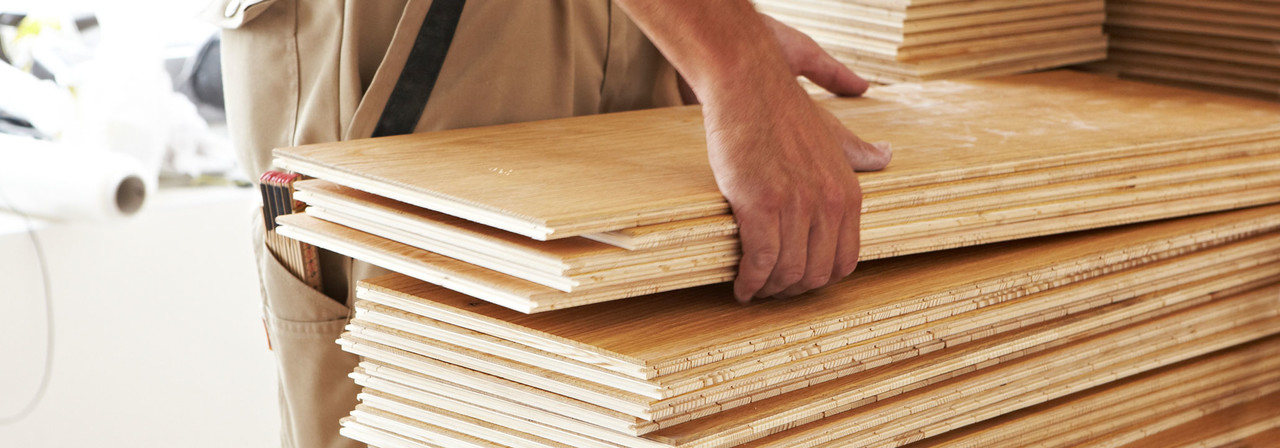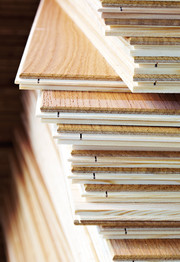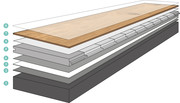Bauwerk parquet structure:
2-layer and 3-layer parquet
Precision, quality and elegance: the multi-layer parquet structure is the basis for these features of our parquet.

Precision, quality and elegance: the multi-layer parquet structure is the basis for these features of our parquet.
Precision, quality and elegance: the multi-layer parquet structure is the basis for these features of our parquet.
One of the many advantages of parquet is its longevity. The durability of the top layer of the parquet is a decisive factor here, but it’s not the only one: The structural quality, the impeccable bonding of components, and the precise processing are all decisive factors for the durability of the parquet.
Bauwerk Parkett offers three different types of parquet structure in its range:
We guarantee top Bauwerk quality based on professional competence and the latest technology, regardless of the structure you choose. Years of experience, precision and efficiency are key for quality-critical process steps. All that comes into play when producing our 2-layer and 3-layer parquet: The top layer is bonded and pressed to the base using a stack press. The adhesive we use is formaldehyde-free, eco-friendly and 100% healthy for living.



2-layer parquet:
Spruce-fir underlayer
2-layer parquet:
HDF sublayer
3-layer parquet
middle layer in spruce with end pieces in HDF

2-layer parquet is always full-surface bonded to the substrate floor. This makes walking on it very quiet. Thanks to its low thickness, this parquet has excellent heat transfer resistance and is very good for installing with underfloor heating. 2-layer parquet can be installed on top of other flooring or fixed structural components without expansion profiles and with virtually no seams.
The top layer of parquet, also known as the wear layer, is at least Solid wood2.5 mm thick. Different types of high-value wood are used for the top layer, including oak, beech, maple, walnut and cherry. If necessary, the top layer can be sanded down and renovated, multiple times, thus making it a particularly resource-saving option.
The sublayer consists of softwood elements (spruce-fir underlayer) or a wooden composite (HDF) bonded orthogonally to the top layer.
This sublayer is the classic option for parquet, containing 100% authentic European wood. To achieve the high quality Bauwerk is known for, we only use wood with vertical annual rings, because it tends to exhibit less swelling and shrinkage than horizontal ones.
Thanks to HDF technology, Bauwerk combines the natural look and unique feel of authentic wooden floors with impressive performance and durability. This high-tech parquet offers all the advantages of a wooden floor with a traditional spruce base and a top layer of 2.5 to 3 mm. HDF bases make more sustainable, economical use of valuable high-grade wood possible.
With their high density and fully bonded top layer, parquets with HDF bases have consistent form stability. Bauwerk’s HDF parquet can therefore be sanded as often as parquets with classic softer wood bases, which need a thicker top layer. The effective usability and durability of parquet are not primarily defined by the top layer thickness; instead, it is determined by structural quality, perfect top layer grip and precise processing.
3-layer parquet sets lower requirements for the underfloor base and facilitates floating installation. It is also suited for installation with underfloor heating. The parquet elements are joined together using tongues and grooves, or click technology.
The top layer of parquet, also known as the wear layer, consists of authentic wood and is at least 3.5 mm thick. Different types of high-value wood are used for the top layer, including oak, beech, maple, walnut and cherry.
The middle later consists of softwood elements (spruce-fir underlayer) with HDF end pieces bonded orthogonally to the top layer.
prefinished 3-layer parquet has a stabilising layer. It stabilises the entire structure and also consists of fir veneer.

1) Screed
2) Adhesive
3) Countermove with spruce veneer
4) White glue
5) Spruce-fir middle layer with HDF end pieces
6) White glue
7) Top layer
8) Various layers of lacquer or oil
Neudorfstrasse 49
9430 St. Margrethen
T +41 71 747 74 74
In 1935, Ernst Göhner brought the idea of solid parquet to mass production before founding Bauwerk Parkett in 1944. Since then, Bauwerk has been researching, developing, and manufacturing innovative, aesthetic parquet solutions of the highest quality with great passion and Swiss precision. Original parquet floors by Bauwerk, one of Europe’s leading parquet manufacturers, offer the unique feel of a real piece of nature that provides tangible warmth and healthy living for a perfectly balanced atmosphere in any room. Experience Bauwerk’s diverse range of wooden floors in one of our showrooms and get our advice without any obligations.